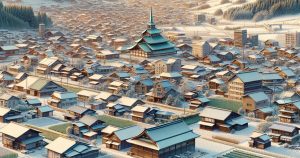| population | 2,725 peoples |
|---|---|
| area | 283.35 km² |
| population density | 9.62 peoples/km² |
Numata Town, located in the northern part of the Sorachi Subprefecture in Hokkaido, is a small yet historically rich community surrounded by magnificent natural landscapes. The town lies on the northern bank of the Uryu River, with mountains enclosing it on three sides. Development began in 1894, when Kisaburo Numata, a rice merchant from Toyama, started the cultivation of this area. Since then, the town has evolved into a thriving agricultural hub, with rice farming, tomato cultivation, and mushroom production at its core. Numata’s signature product, “Yukichu-mai” (snow-stored rice), is renowned across Japan for its sweet flavor enhanced by the natural cold of Hokkaido’s snow chambers. Life in Numata is characterized by the close connection between nature and community. Each season brings a new landscape—lush greenery in summer, brilliant foliage in autumn, and pure white snow in winter. Traditional culture, including Ainu influences and local dialects, remains deeply woven into daily life. Visitors will find both the warmth of small-town hospitality and the beauty of unspoiled northern Japan. Events such as the Yotaka Andon Festival and the winter “Hotaru no Sato Snow Lights” celebration showcase the town’s creative spirit and strong sense of togetherness.
Culture and Traditions
Numata Town has developed through its agricultural heritage and the pioneering efforts of its founders. The spirit of Kisaburo Numata—who built the first farms and donated land for public use—still resonates in the cooperative lifestyle of local residents. The town’s cultural identity has been shaped by a balance of Ainu roots, respect for nature, and community solidarity.
The Yotaka Andon Festival is the most famous local event, inherited from Tsuzawa, Toyama Prefecture, in 1977. Gigantic illuminated floats called “andon” are paraded through the streets and then dramatically clashed together, filling the summer night with light, sound, and energy. This powerful spectacle has become a symbol of Numata’s identity and attracts visitors from all over Japan.
In winter, the town hosts the Hotaru no Sato Winter Lights Festival, where hundreds of handmade snow lanterns create an enchanting, glowing landscape. Throughout the year, local residents continue to speak in the Hokkaido dialect and maintain close-knit community relationships. Numata’s culture embodies both resilience and warmth—a living reflection of Hokkaido’s pioneering spirit.
Local Specialties
- Yukichu-mai (Snow-Stored Rice): Numata’s premium rice, preserved in natural snow chambers to maintain its sweetness and texture. The unique storage method utilizes the region’s cold climate to enhance flavor naturally.
- “Kita no Hotaru” Tomato Juice: Made from perfectly ripened local tomatoes, this juice features a rich and natural sweetness balanced with refreshing acidity.
- Snow-Grown Shiitake Mushrooms: Cultivated in snow-covered conditions, these mushrooms are known for their dense umami and fragrant aroma, a local delicacy used in restaurants and gift sets.
- Craft Beer – Ishikari Numata Brewery: Japan’s first municipally operated craft beer brewery. Its fresh, crisp flavor uses locally grown barley and the pure underground water of the Sorachi region.
- Japanese Sake “Yukinagori – Zuika”: Brewed with local rice and snowmelt water, this sake delivers a clean, smooth taste and is served at local events and festivals.
Annual Events
- Yotaka Andon Festival (Mid-August): Numata’s signature summer event, featuring massive illuminated floats colliding in a vibrant display of light and tradition.
- Hotaru Festival (Mid-July to Early August): Held in the Horoshin district’s “Firefly Village,” this magical event invites visitors to enjoy summer nights illuminated by thousands of glowing fireflies.
- Snow Festival (February): A winter celebration with snow sculptures, food stalls, and outdoor games—bringing warmth and joy to the cold season.
- Asumo Harvest Festival (September): Hosted at the famous “Asumo Station” (former Ebisu Station) filming location from NHK’s drama Suzuran, this festival offers fresh farm produce and local entertainment.
Access
- By Train: JR Hokkaido’s Ishikari-Numata Station on the Rumoi Line is the main railway stop, about 30 minutes from Fukagawa Station.
- By Car: Take the E62 Fukagawa–Rumoi Expressway and exit at Numata Interchange. Travel time is roughly 2 hours from Sapporo or 1.5 hours from Asahikawa.
- By Bus: Local and municipal buses connect Numata Town with Fukagawa and nearby towns, with a journey of around 40 minutes from Fukagawa Station.
- By Air: The nearest airport is Asahikawa Airport (approx. 90 minutes by car). From New Chitose Airport, the drive takes about 2.5 hours.
Tourist Attractions
- Horoshin Onsen Hotaru-kan – A scenic hot spring surrounded by forests. It offers open-air baths, lodges, and a campsite for families.
- Hotaru no Sato Auto Campground – A tranquil campground known for summer firefly viewing and nature experiences.
- Asumo Station (Former Ebisu Station) – The iconic filming site of NHK’s morning drama Suzuran. The preserved wooden station attracts film fans year-round.
- Numata Fossil Experience Museum – Displays fossils discovered in the region and offers hands-on fossil excavation for children and visitors.
- Moe Hill – A panoramic viewpoint featured in the TV drama Suzuran. Visitors can overlook the town’s peaceful rural scenery.
- Numata Yotaka Hall – Exhibits large festival floats and introduces the history and artistry behind the Yotaka Andon Festival.








